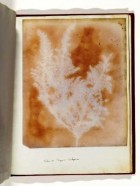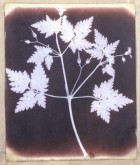Από τις πρώτες φωτογραφίες του κόσμου τα φυτά της Κέρκυρας-From the first pictures of world the plants of Corfu
ArtistWilliam Henry Fox Talbot (English, 1800–1877)
Inscribed Title
Thapsia Asclepium from Corfu
Από το Βρετανικό Μουσείο
Ο·William Henry Fox Talbot επισκέφθηκε την Κέρκυρα το 1926 και ήταν λάτρης της Βοτανολογίας.Σχετική επιστολή του για την Βοτανική στην Κέρκυρα δημοσιεύεται πιο κάτω.
Wikipedia
(Από "Προσωπικότητες εν Κερκύρα" του Θ.Μεταλληνού)
William Henry Fox Talbot ήταν Βρετανός εφευρέτης και πρωτοπόρος της φωτογραφίας, γεννήθηκε στις 11 του Φλεβάρη 1800 και πέθανε στις 17 Σεπτεμβρίου του 1877. Ήταν ο εφευρέτης της διαδικασίας καλοτυπία, ο πρόδρομος για τις περισσότερες φωτογραφικές διεργασίες του 19ου και του 20ου αιώνα. Ήταν επίσης πρέπει να σημειωθεί φωτογράφος που έκανε σημαντικές συνεισφορές στην εξέλιξη της φωτογραφίας ως καλλιτεχνικό μέσο. Το έργο του στη δεκαετία του 1840 σε μια φωτογραφία-μηχανική αναπαραγωγή οδήγησε στη δημιουργία της photoglyphic διαδικασίας χαρακτικής,δηλ. ο πρόδρομος της φωτοχαρακτικής. Ο Talbot αναφέρεται επίσης ως ο κάτοχος του διπλώματος ευρεσιτεχνίας η οποία, κάποιοι λένε, επηρέασε την έγκαιρη ανάπτυξη της εμπορικής φωτογραφίας στη Βρετανία. Επιπλέον, έκανε κάποιες σημαντικές αρχικές φωτογραφίες της Οξφόρδης, του Παρισιού, και της Υόρκης.
Ταλμποτυπία
Νωρίτερα από τον Νταγκέρ, ο Άγγλος λόγιος και επιστήμονας Ουίλιαμ Τάλμποτ (William Fox Talbot) είχε ανακαλύψει μια άλλη αντίστοιχη μέθοδο, από το 1835, την οποία είχε κρατήσει μυστική. Μετά την γνωστοποίηση της δαγκεροτυπίας, έσπευσε να την ανακοινώσει ερχόμενος και σε ρήξη με τον Νταγκέρ σχετικά με την πατρότητα της φωτογραφίας. Ο Τάλμποτ ονόμασε αρχικά την τεχνική του «καλοτυπία» αλλά αργότερα μετονομάστηκε σε «ταλμποτυπία». Επρόκειτο ουσιαστικά για την δημιουργία μιας ενδιάμεσης αρνητικής εικόνας, που αργότερα μπορούσε να χρησιμοποιηθεί για την αναπαραγωγή της θετικής, πραγματικής εικόνας. Η καλοτυπία υστερούσε σε ποιότητα έναντι της δαγκεροτυπίας, ωστόσο αυτό ήταν λογικό καθώς χρησιμοποιούσε ως βάση του αρνητικού, χαρτί, του οποίου η υφή διακρινόταν πάνω στη φωτογραφία.
Από πολλούς ο Τάλμποτ θεωρείται πατέρας της σύγχρονης φωτογραφίας, κυρίως διότι συνέλαβε τη σχέση ανάμεσα στην αρνητική και θετική φωτογραφία. Οι όροι αρνητικό και θετικό χρησιμοποιήθηκαν για πρώτη φορά από τον Τζον Χέρτσελ (Sir John Frederick William Herschel), φίλο του Τάλμποτ. Επιπλέον ο Τάλμποτ ήταν ο πρώτος που δημοσίευσε βιβλίο με συλλογή φωτογραφιών, ενώ λειτούργησε την πρώτη επιχείρηση μαζικής αναπαραγωγής και πώλησης φωτογραφιών στο Reading, κοντά στη πόλη του Λονδίνου.
Με βάση την πιο πάνω φωτογραφία παρόμοιες με αυτή είναι και οι πιο κάτω που επειδή δεν έχουν χαρακτηριστεί και με βάση τα όσα γράφει στην επιστολή του από την Κέρκυρα μπορούμε να υποθέσουμε αποτελούν μια σειρά.
Ίσως είναι από τα πειράματά του πριν ανακοινώσει επίσημα την εφεύρεσή του.
Η Επιστολή του από την Κέρκυρα
Island of Corfu - 31st March 1826
Dear Sir,
I imagine it will be agreeable to you to have some account of the Botany of this island, which you may compare with that of Sibthorp <1> & others who have visited it probably at different seasons of the year. The aspect of it is very mountainous & clothed with olive woods; near the city, a fertile plain; I have not yet extended my rambles to any distance from the city; The orange trees are magnificent, and are now loaded with fruit; the olives are covered with their black berries. Gigantic Arundo Donax, and Cactus Opuntia of considerable size diversify the prospect. The extensive cultivation of the Artichoke is curious, it serves for hedges, & very pretty ones; there are hedges too of scarlet Cape Geraniums, more I think for ornament than protection In fact it is an open country, a garden. Here is a sort of calendar of Flora, which you may compare with Norfolk on the same day, if you have made similar notes: –
Corfu, on 31st March. - Elder-tree in flower; Brambles, do
Pomegranate, in young leaf, having the appearance of a red bush; Figtree in young leaf; Scrophularia peregrina in flower; along with the following plants in flower: –
Chrysanthemum segetum; Common Scarlet Poppy; Lathyrus alatus; Fumaria capreolata; Geranium, unknown to me, – like molle, but five or six times larger,– not pyrenaicum; Thlaspi Bursa pastoris, of a size little inferior to Cardamine amara; Asphodelus ramosus and Phlomis fruticosa, very showy plants; Anemone hortensis; Hyacinthus raccmosus; Ornithogalum exscapum (of Tenore), nanum (Sibth.?) which seems a mere variety of umbellatum; Helleborus viridis – this is not in Prodr. Fl. Græc.; <2> Lycopsis variegata, a charming plant, forming here extensive fields of blue; – Sibthorp says it is rare in Peloponnesus and the Archipelago, so that I suppose this island is its head-quarters; Ajuga reptans, extremely large; Symphytum tuberosum; Linum usitatissimum; Euphorbia dendroides; Chrysanthemum coronarium; Erodium malacoides and moschatum; Lotus ornithopodioides; Echium calycinum (not in Prodromus; Tordylium officinale, – this is the commonest umbelliferous plant on the island. At Ancona, in Italy, I saw the other day a scarlet corn-field; – arrived at the spot, I found it owing to a profusion of Tulipa Oculus Solis. – The weeds of the South of Europe are very handsome.
April 2d.
I can add to the list two Ophryses which are not in the Prodromus, – lutea, and aranifera, besides tenthredinifea. I observed today, in flower, Anagallis arvensis and cœrulea; Hippocrepis unisiliquosa; Saponaria ocymoides (not in Prodromus); Lunaria rediviva; Astragalus monspessulanus; Galium cruciatum; Spartium villosum; Cistus salvifolius; Anthyllis vulneraria (flore rubro), and Vicia lutea? Veronica Buzbaumii; Bellis annua; Scorpiurus subvillosa; Phalaris utriculata, very abundant (not in Prodr.) ; Trifol. resupinatum: Sherardia arvensis; Geranium dissectum; Lithosp. purpureo-cœruleum; and a noble Echium. I am convinced the beautiful Geranium of this island is distinct from pyrenaicum: the flowers are a fine rose colour, of the size of a sixpence, ornamenting all the road sides. Hedysarum coronarium (not in Prodr.). I wonder this showy flower did not fall in Sibthorp’s way.– I have found a Senecio that may be new: it is like vulgaris, wanting the ray florets, but much larger, and pale sulphur yellow, with long slender florets that are protruded and make a sort of bush.
April 4th
There are now in flower some plants not in the Prodromus, viz. Lotus maritimus; Vicia grandiflora (sordida, Willd.). Cerastium maniticum (a curious species, hitehrto little understood, to which I would give the following specific character: "Cerastium erectum glaberrimum pedunculis longissimis erectis, clayce membranacco, petalis fere integris.” A curious little Euphorbia, (nova species?) resembling E. Peplus a little, but has a 5-rayed umbel, and echinate capsules: the petals also are entire, not lunate or horned. A species of Muscari with blue flowers of a large size.– Besides these, which seem a Melope additions to the Flora Græca, I see a beautiful Malvaceous plant, – a Malope, with rosy flowers 3 inches in diameter; blue Lupins; Bartsia latifolio: Serapias Lingua: Delphinium Stapisagria (not in flower); Coronilla cretica; Medicago circinata; Ornithopus compresus; Trifol. subterraneum; Picridium vulgare; Thelygonum Cynocrambe.
I remain, Dear Sir, with the greatest regard,
H. F. Talbot
Κέρκυρα - 31 Μαρτίου, 1826
Αγαπητέ Κύριε,
Φαντάζομαι ότι θα είναι ευχάριστο για σας να έχεις ένα βαθμό υπόψη τη Βοτανική του νησιού, η οποία μπορεί να συγκριθεί με εκείνη του Sibthorp και με άλλα μέρη που το έχεις επισκεφθεί κατά πάσα πιθανότητα σε διαφορετικές εποχές του έτους. Το χαρακτηριστικό του είναι πολύ ορεινό και ντυμένο με ελαιώνες? Κοντά στην πόλη, μια εύφορη πεδιάδα? Δεν έχω επεκταθεί ακόμα σε περιπάτους μου σε απόσταση από την πόλη? Οι πορτοκαλιές είναι μεγαλειώδεις, και τώρα φορτώνονται με τα φρούτα?Οι ελιές καλύπτονται με μαύρα μούρα από μουριές. Γιγαντιαία Arundo Donax, και Cactus Opuntia σημαντικού μεγέθους διαφοροποιούν το όλο τοπίο. Η εκτεταμένη καλλιέργεια της αγκινάρας είναι περίεργο, χρησιμεύει για φράκτες, και είναι πολύ όμορφο αυτό? Υπάρχουν αντισταθμίσεις πολύ από οστρακιά Cape γεράνια, περισσότερο πιστεύω για στολίδι από την προστασία Στην πραγματικότητα είναι μια ανοιχτή χώρα, ένας κήπος. Εδώ είναι ένα είδος καταλόγου της χλωρίδας, την οποία μπορείτε να συγκρίνετε με το Norfolk την ίδια ημέρα, εάν έχετε κάνει παρόμοιες σημειώσεις: -
Κέρκυρα, στις 31 Μαρτίου. - Γέροντας-δέντρο, λουλούδι? Brambles,
Ρόδι, με νεαρά φύλλα, που έχει την εμφάνιση του κόκκινου θάμνου? Figtree σε νεαρά φύλλα? Scrophularia Peregrina στο λουλούδι? Μαζί με τα ακόλουθα φυτά σε άνθηση: -
Χρυσάνθεμο segetum? Κοινή Scarlet παπαρούνας? Lathyrus alatus? Fumaria capreolata? Geranium, άγνωστος σε μένα, - όπως Molle, αλλά πέντε ή έξι φορές μεγαλύτερη, - δεν pyrenaicum? Thlaspi Προύσα pastoris, με μέγεθος λίγο κατώτερη από Cardamine amara? Asphodelus ramosus και Phlomis fruticosa, πολύ ελκυστικά φυτά? hortensis Anemone? Ζουμπούλια raccmosus? Ornithogalum exscapum (του Tenore), nanum (Sibth.;) που φαίνεται μια απλή ποικιλία umbellatum? Helleborus viridis - αυτό δεν είναι σε Prodr. Fl. Græc? <2> Lycopsis variegata, ένα πανέμορφο φυτό, που είναι εδώ εκτεταμένο σε τομείς του μπλε? -. Sibthorp λένε ότι είναι σπάνιο στην Πελοπόννησο και το Αρχιπελάγος, έτσι ώστε να υποθέτω ότι αυτό το νησί είναι το κέντρο του.? Ajuga reptans, εξαιρετικά μεγάλες? Symphytum tuberosum? Linum usitatissimum, που? Euphorbia dendroides? Chrysanthemum coronarium? malacoides Erodium και moschatum? Lotus ornithopodioides? Echium calycinum (δεν περιλαμβάνονται στο Προδρόμου?. officinale Tordylium, - αυτή είναι η συνηθέστερη (umbelliferous)? φυτό του νησιού στην Αγκώνα, στην Ιταλία, είδα το προάλλες μια ερυθράπεδιάδα από καλαμπόκι και έφτασα σ’αυτό το σημείο, διότι βρήκα πληθώρα των Tulipa Oculus Solis - Τα ζιζάνια του Νότου της Ευρώπης είναι πολύ ωραία
..
Απρίλιος 2.
Μπορώ να προσθέσω στον κατάλογο δύο Ophryses που δεν είναι στο Προδρόμου, - lutea, και aranifera, εκτός tenthredinifea. Παρατήρησα σήμερα, σε λουλούδι, Anagallis arvensis και coerulea? Hippocrepis unisiliquosa? Saponaria ocymoides (δεν Προδρόμου)? Lunaria rediviva? Monspessulanus Astragalus? Cruciatum Galium? Spartium villosum? Cistus salvifolius? Anthyllis vulneraria (Flore rubro), και Vicia lutea; Veronica Buzbaumii? Bellis annua? Scorpiurus subvillosa? Phalaris utriculata, πολύ πλούσια (όχι σε Prodr.)? Trifol. resupinatum: Sherardia arvensis? Geranium dissectum? Lithosp. purpureo-cœruleum? και μια ευγενή Echium. Είμαι πεπεισμένος ότι το όμορφο Γεράνι του νησιού είναι διαφορετικό από pyrenaicum: τα λουλούδια έχουν ένα λεπτό τριανταφυλλί χρώμα, το μέγεθος των έξι πένες, διακοσμόντας όλες τις πλευρές των οδών. Hedysarum coronarium (δεν Prodr.). Αναρωτιέμαι αυτό το επιδεικτικό λουλούδι δεν έπεσε στο δρόμο του Sibthorp .- Έχω βρει ένα Senecio που μπορεί να είναι νέα: είναι σαν vulgaris, που θέλουν την florets ακτίνων, αλλά πολύ μεγαλύτερη, με χλωμό θείο κίτρινο, με μακρά πέταλα λεπτά που προεξέχουν και κάνουν ένα είδος θάμνου.
4 Απριλίου
Υπάρχουν τώρα στο λουλούδι στο Προδρόμου, δηλαδή ορισμένα φυτά όχι. Lotus maritimus? Vicia grandiflora (sordida, Willd.). Cerastium maniticum (ένα περίεργο είδος, hitehrto λίγο κατανοητή, για τη οποίο θα δώσω την εξής ιδιαιτερότητα:; ". Cerastium erectum glaberrimum longissimis pedunculis erectis, membranacco clayce, petalis ΦΕΡΕ Integris" Μια περίεργη Euphorbia, (nova είδη) που μοιάζουν Ε. Peplus λίγο, αλλά έχει ένα 5-Rayed σκιάδιο, και echinate κάψουλες: τα πέταλα, επίσης, είναι όλο, δεν ημισεληνοειδής ή κέρατα Ένα είδος Muscari με μπλε λουλούδια μεγάλου μεγέθους .- Εκτός από αυτά, τα οποία να φαίνεται προσθήκες Melope στο. Flora Graeca, βλέπω μια όμορφη Malvaceous φυτό, - ένα Malope, με ρόδινα άνθη 3 ίντσες σε διάμετρο? μπλε λούπινα? Bartsia latifolio: Serapias Lingua: Δελφίνιο Stapisagria (δεν περιλαμβάνονται στο λουλούδι)? Coronilla cretica? Medicago circinata? Ornithopus compresus? Trifol. subterraneum? Picridium vulgare? Thelygonum Cynocrambe.
Παραμένω, Αγαπητέ Κύριε, με τη μεγαλύτερη σχέση,
Η. Φ. Talbot
In 1823 and 1826 Talbot chartered expeditions to Corfu and the Ionian Islands collecting plants which he then spent the following years studying and classifying. One of the plants discovered on these expeditions ‘Sideritis purpurea Talbot’ still bears his name as does ‘Talbotia elegans Balfour’ named years later in his honour by the Scottish botanist, Professor John Hutton Balfour (1808-1884). Below is part of Talbot’s list of plants collected for either Sir William Jackson Hooker or his son Sir Joseph Dalton Hooker (1817-1911). - See more at: http://britishlibrary.typepad.co.uk/untoldlives/science/page/2/#sthash.xKo1AJDO.





